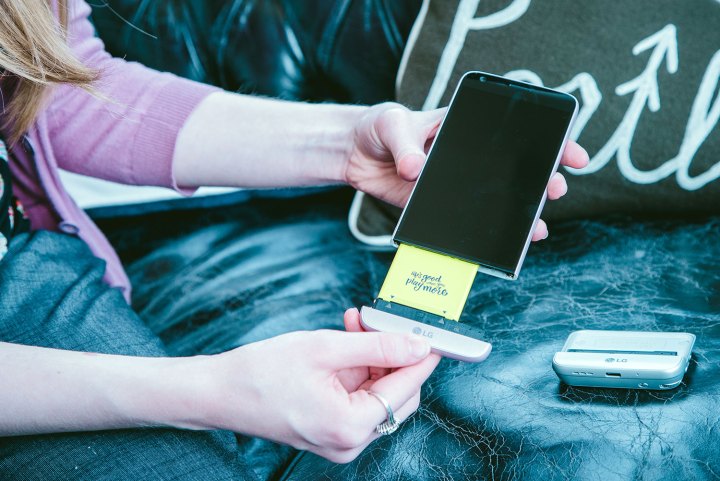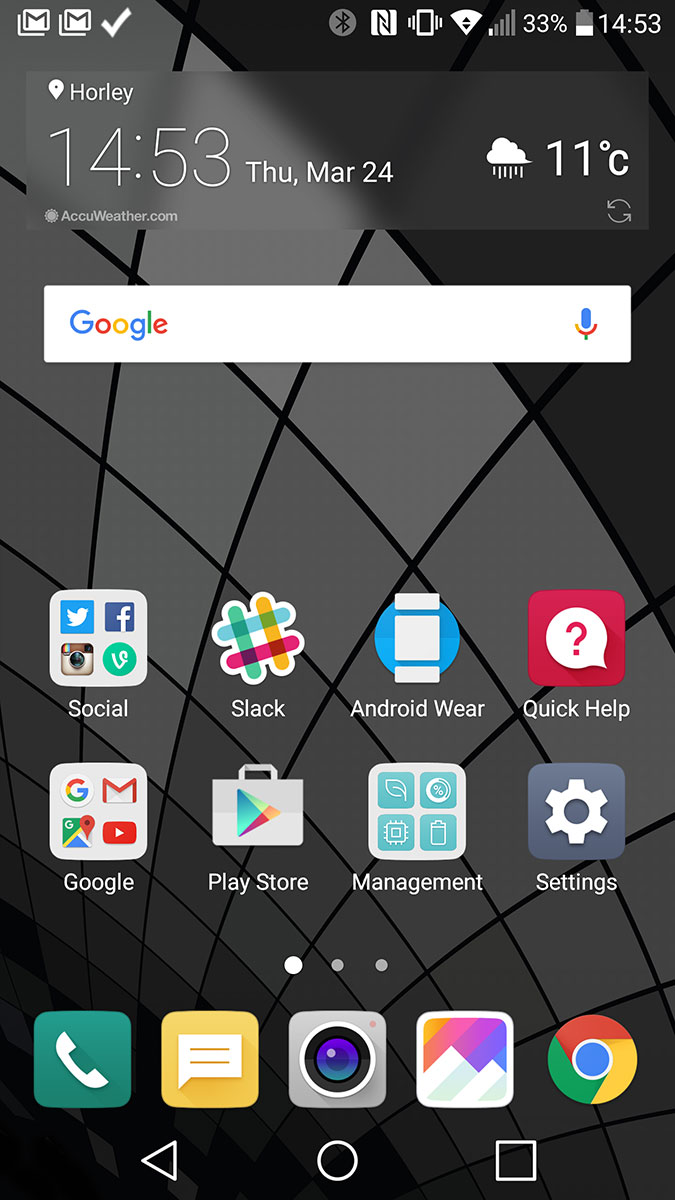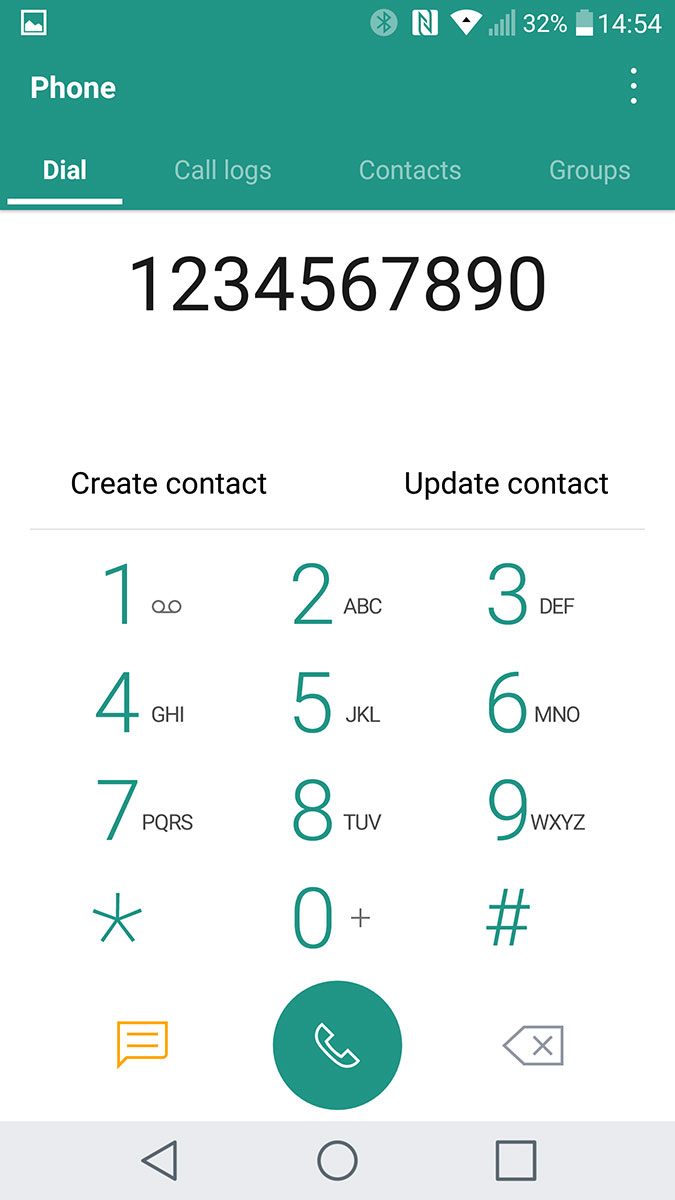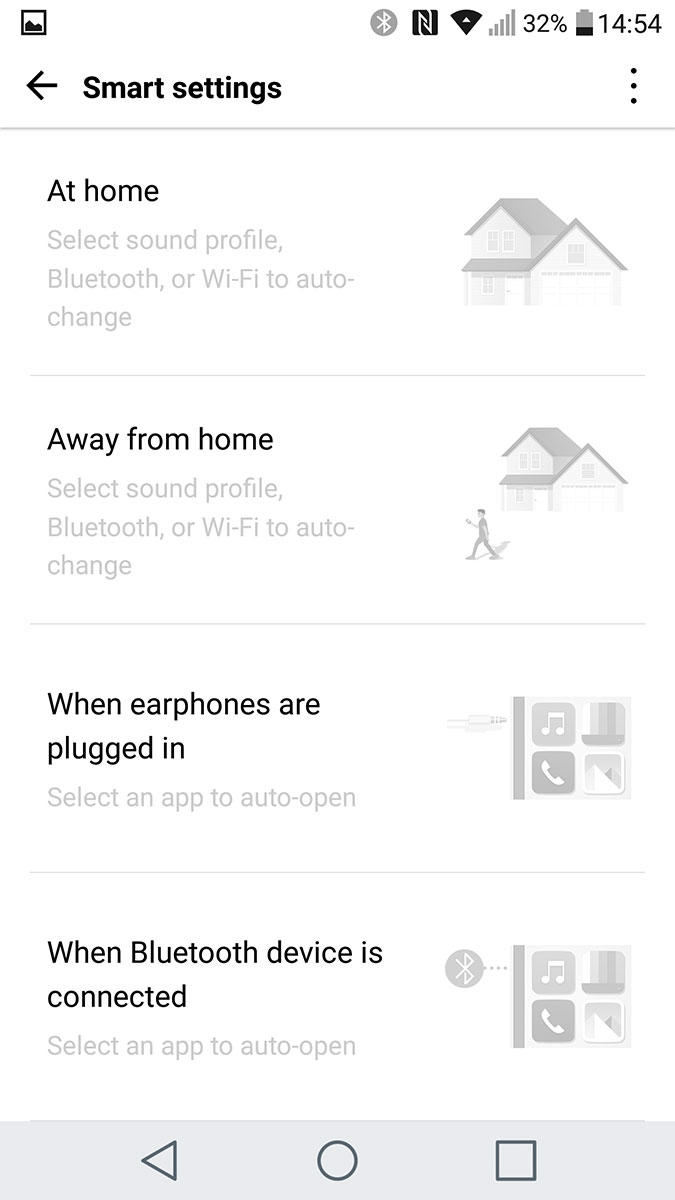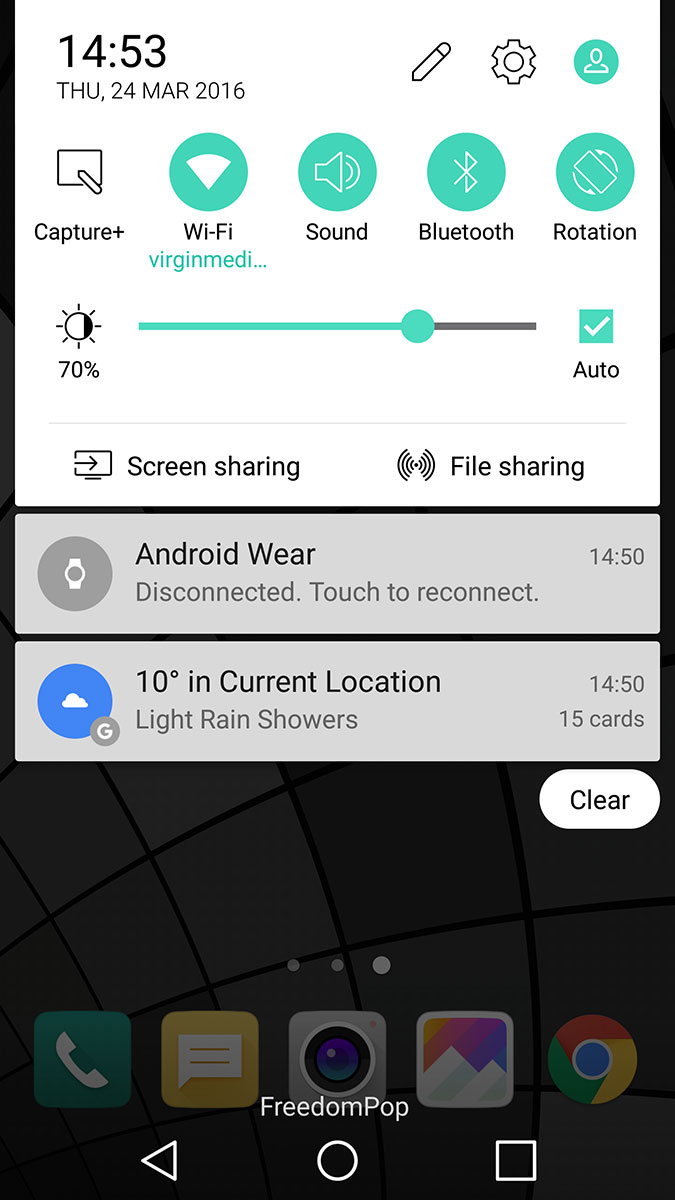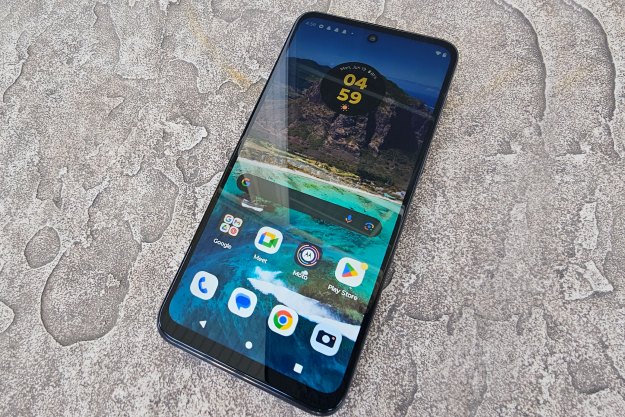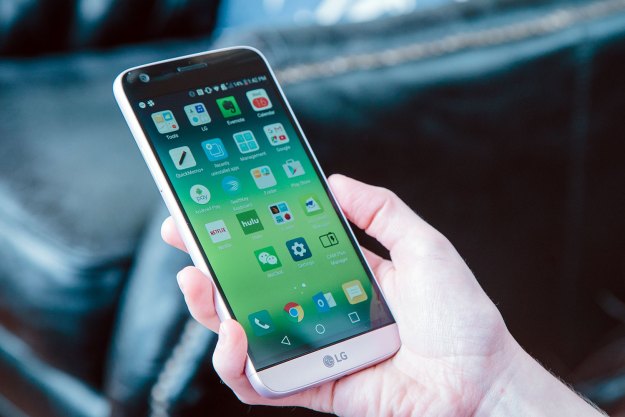
- Modular design with replaceable battery
- Sleek metal body
- Amazing camera
- More than enough power
- Considerable potential for the future
- Future potential has yet to be realized
- Battery life is weak
- Modules are hard to connect
LG is facing a gigantic challenge in 2016. It’s launching directly against the Samsung Galaxy S7, a phone that improves on an already excellent platform to become an incredibly accomplished smartphone. To combat Samsung and the omnipresent iPhone, LG has decided to innovate and rethink how we use smartphones.
The G5 is really different. It’s a phone that has a bottom and battery that detach, allowing you to clip in new modules that give the G5 special abilities, like a better camera or higher-quality sound. It’s a small change, but damn exciting because of what it represents and what it could mean for the future.
But is the world ready for camera-enhancing modules or clip-in high-performance audio DACs?
For the G5 to be a success, people need to see the potential of the modules, but they also have to love the phone. Outshining Samsung and Apple is a gargantuan task, and LG’s out of left field. Does the G5 have what it takes to make people buy it and dive into the world of modular smartphones?
Editor’s Note: We tested a pre-production model for several days to see how the G5 performs alone, and with the CamPlus module attached. We will update this review when we receive final versions of the phone and modules.
The magic’s in the slot
LG will tell you the G5’s appeal lies inside the ‘magic slot,’ the unofficial name for the phone’s modular port. It’s located at the base of the device, and always houses the battery, which attaches to the module of your choice. On the phone’s right-hand side is a small, flush-mounted button that requires a firm press to activate. It pops the lower section of the phone out, disconnects the battery, and allows the entire module to be removed.
- 1. LG G5
The battery unclips with a firm, sideways tug, and is reattached to the new module, which is slid back into the phone. It’s neat, well designed, and sensibly made. It doesn’t just unclip and let everything clatter to the floor either. You need to make the effort to pull the module free. You need a firm hand to remove the battery the mounting points, and replacing the module requires a solid final push to secure it back in place. None of these steps will be completed by accident, so the G5 won’t disassemble if you happen to look at it strangely.
However, it all feels very alien. We’re used to treating our phones like delicate little flowers, and the G5 needs some rough treatment to swap the modules. The first few times you do it, you’re going to wonder if it’s about to break. Will it? No, certainly not if you follow the instructions. Unless you drop the phone, you’ll be fine.
The amount of work, thought, effort, and commitment that has gone into creating the G5 is astonishing.
The first time we swapped modules, we were so afraid we would break the phone, that we asked another colleague, who’d had practice to do it. It took a couple rounds of swapping modules to get comfortable with the harsh tugging and pulling, and even then, it felt decidedly wrong. We can’t really imagine your average Joe swapping modules, but tech geeks will love it.
We also wish there were an easier way to swap modules, or that it each module came with its own battery, so we didn’t have to yank the battery out every time. Alternatively, keeping the battery tucked away in the back would be nice, so that swapping modules doesn’t involve any battery swapping at all. Of course, that would annoy those who want a removable battery pack.
An amazing camera that steals the show
The LG G4 and the LG V10 are two of the very best
The first camera provides a regular view of the world, while the second gives an expanded 135-degree wide-angle view, providing ample opportunity for creativity. They’re used independently of each other, unless you activate a special pop-out mode, where the two viewpoints are meshed together to create weird hybrids. It’s a feature that won’t be used that often, but can produce fun collages, if you’re patient.
Using the wide-angle lens is addictive. It changes the camera view completely, and changes the way you think about framing, composition, and focal points. Get it right, and the results looks superb, especially when taking pictures of vistas and wide-open spaces. There is a slight fish-eye effect to the G5’s wide-angle pictures, but again, provided you put some thought into the final image, it’s not distracting.
LG has included its incredibly easy-to-use manual mode for the G5, where ISO, shutter speed, focus, and white balance can be adjusted. It’s the most user-friendly manual mode we’ve used, and it never feels like you’re going to make a terrible mess of things when fiddling around with the settings. You’ll find yourself using it to tweak pictures rather than setting it to auto, due to its simplicity.
Low light performance is superb. Even using auto mode, it slowed the shutter speed down to a point where a tripod was needed to steady the shot and eliminate blur. Switching to manual mode compensated for the circumstances, but the picture wasn’t as good as it could have been. The software wasn’t final on the G5 we used, so we’ll update this review when we’ve used the complete version.
Zooming in on subjects is handled differently on the G5, utilizing both lenses for a fluid, more detail orientated digital zoom feature. It’s still no match for an optical zoom, and although it has a greater range than other digital zooms, the results are hardly worth the effort.
The 8-megapixel selfie camera also has a wider angle than other phones, such as the
The G5’s camera is a complete pleasure to use; it’s a huge selling point for the phone. It’s fun and easy to learn, and because the results are usually beautiful, you’ll want to use it more often. The wide-angle lens differentiates the phone from the competition — and is an improvement over the G4 and V10 — even if the overall picture quality and general usage is essentially the same. It’d be harsh to say it’s not a worthy upgrade from either of those two phones, given the G5’s other features.
Using the CamPlus module
Given how well the G5’s camera performs, you’d almost wonder why you even need the CamPlus module. However, after using an early version of the CamPlus, we can honestly say that it enhances the G5’s camera, creating even more high-quality images. The main area in which the CamPlus shines is with its zoom feature.
The module isn’t very big, even though it holds an extra battery pack to keep your phone charged while you’re off being a shutterbug. There’s a dedicated photo button, a button for recording video, and a zoom wheel. When we zoomed in on a street sign from a full, long block away in NYC with the CamPlus, we could easily read the tiny street number on the sign and other details that were impossible to see with the human eye. We did the same thing with the standard zoom on the Galaxy S7 Edge and iPhone 6S Plus, and the results with both phones were more grainy and the street sign’s letters were almost indistinguishable.
The CamPlus module sees things that other smartphone cameras can’t, and it’s truly impressive.
The CamPlus module sees things that other
We felt some occasional software hiccups when the zoom wheel just wouldn’t work, or the camera had a hard time focusing, but LG reminded us that it’s an early prototype of the CamPlus and that refinements will be made before launch.
The CamPlus’ $70 price tag may give you pause, but if you like to take photos and find yourself wishing for a better zoom on your phone, the CamPlus is for you. We do hope, however, that carriers and LG will offer deals on these modules to make them more accessible to the average user. We’ve yet to try the high-res audio module or the battery back module, but we’ll update as soon as we get them in.
Specs and losing the app drawer in Android 6.0
Android 6.0.1 Marshmallow is under more of a disguise on the G5 than previous LG smartphones, primarily because of the controversial decision to get rid of the app tray. It’ll split opinion, mainly among
- 1. LG G5
All your apps are still there, but instead of tapping another button to find them, they’re spread across multiple home screens. Yes, I missed relegating only the most often used apps to the app drawer to place more emphasis on the wallpaper, but with careful sorting folders, it’s still possible to individualize the G5.
LG’s list of pre-installed apps isn’t that long, and includes the usual apps for email, contacts, and the weather, plus tools like a voice recorder, calculator, task manager, and handily, an FM radio. A selection of battery, storage, and memory saver tools are also onboard. None can be uninstalled. There’s also the LG Friends app, which helps you connect the modules properly. That process is remarkably easy: Once the module is in, the phone detects it, and you tap on its name to connect in the app. Done!
The G5 is a fireball with Qualcomm’s Snapdragon 820 and 4GB of
Battery life needs improvement
If the G5’s processor makes it an absolute beast, what about the battery? We’ll start with the positives. It’s completely replaceable, so if you carry a spare, it takes seconds to swap it out for a freshly charged one. Try that in any other major flagship phone in 2016. In fact, try it in any metal phone at all. It can’t be done, and it’s only possible on the G5 because of LG’s radical modular design.
It’s not incredibly long lasting, but it’s not really that different from the Galaxy S7 or
Recharging will have to happen every other day, and potentially part way through it. If you hit the GPS for about two hours, take some photos, and generally use the phone for email, messages, and apps; the battery will give up at the end of the day. It’s not incredibly long lasting, but it’s not really that different from the Galaxy S7 or
It also has QuickCharge 3.0, which is a step ahead of the Galaxy S7’s QuickCharge 2.0 standard. It juiced up quickly when we needed it to regain power fast. The absence of wireless charging will no doubt disappoint some of you, but that’s one of the things about metal – It doesn’t let signals penetrate so well.
Demure design
Finally, we come to the G5’s understated design. It can’t stand up to the beauty of the iPhone or Galaxy S7 Edge. At first glance it looks boring, but it isn’t ugly. In time, we began to like its subtle design details.
There are curves in unexpected places — the top of the screen slopes back towards the chassis, for example — and there are no nasty sharp edges to make it awkward to hold. The metal is smooth and seamless. It doesn’t have any unsightly antenna bands, either, which is a true feat of engineering that not even Apple has accomplished.
If anything, the G5 is too understated, and doesn’t make much of an early impression. Live with it for a while, and you’ll be thankful for its well thought out design and shape.
- 2. LG G5
LG should also be congratulated for making the modular system almost invisible on the G5. When you first look at the phone, you would never know the base slides out. There are no over-sized buttons, no silly arrows painted on the body, and no ugly breaks in the chassis. It’s all handled with maturity and style.
Although it’s not much smaller than the
We need more updates
LG usually updates its phones at least once, but its record isn’t much better than that of Samsung or any other
Warranty and durability
LG placed a one-year parts and labor warranty on the G5, so if there’s a problem, you’ll have to send it back to the company for repair.
It’s unknown how durable the modules will prove, or if swapping them over and over again will cause and problems. That’s something that will be determined over time. The G5 isn’t water resistant, either, which is one mark against it in the durability column when compared to the Galaxy S7. However, when it comes to drops and falls, metal trumps glass every time, so the G5 will likely win the drop tests.
Conclusion
The amount of work, thought, effort, and commitment that has gone into creating the G5 is astonishing. While other brands are accused of coasting along with endless rehashes of previously successful handsets, LG has come out with something that drives the
However, at the moment, the potential of the modular phone isn’t fully realized. Without a packed playground full of modular pals to play with, the G5’s magic slot is a bit lonely. The only two modules that are out so far – the CamPlus and the high-res audio one — aren’t hugely exciting, and only photography nuts and high-res audio fans will take the plunge and buy one at a $70 price.
So, should you buy the G5 as it stands right now? We think so. It is undoubtedly one of the finest flagship phones of 2016 to date, and you won’t be disappointed by it whether you buy into the modules or not. But if you’re deciding between G5 and Galaxy S7 Edge, right now, we’d opt for the Edge, especially because it supports the best
The LG G5 is a great buy, but isn’t our favorite
Editors' Recommendations
- Visible’s affordable 5G plans just got even cheaper
- This new folding phone costs less than half the price of the iPhone 15 Pro Max
- Does the Moto G Power have NFC?
- Does the Moto G Stylus have NFC?
- The best Moto G Power 5G (2024) cases: 7 great choices


